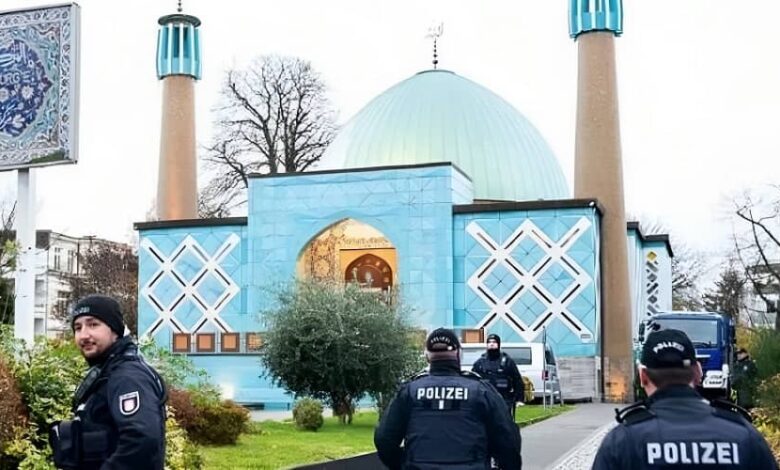Hamburg’s Islamic Center Raid: Just a Surface Scratch on Tehran’s Expansive Network in Europe

germany hamburg islamic center mosque raid (1)
Written by
Shahriar Kia
As part of the probe into the Islamic Center of Hamburg, on Friday, October 16, at 6 a.m., the police in Germany hit up 54 buildings across seven states. Nancy Faeser, Germany’s Interior Minister, revealed that this spot has been on the radar of the Bundesamt für Verfassungsschutz, the country’s intelligence service (Office for the Protection of the Constitution) for a while, and they’ve labeled it an Islamist outfit. Over 500 police officers got in on the action.
The German police weren’t just monitoring the Islamic Center of Hamburg; they were also checking out five other groups believed to be tied to the Iranian regime’s spy network. This sweep went down in Hamburg, Lower Saxony, Hessen, Baden-Württemberg, Bavaria, Berlin, and North Rhine-Westphalia.
The German Ministry of the Interior stated in a statement, “The Islamic Center of Hamburg is suspected of acting against the order based on the constitution and promoting the exchange of ideas between different population groups and cultures. Therefore, it is subject to prohibition under Article 2 of the Basic Law and Article 3 of the Law on Associations.”
The Islamic Center of Hamburg is also suspected of supporting Hezbollah, and investigations in this regard are underway by security entities. Germany had previously declared the activities of Hezbollah in its territory illegal. Berlin believes that other associations whose buildings were searched in Thursday’s operation are believed to be subsidiary branches of the Islamic Center of Hamburg.
This center, along with other intelligence and espionage entities of the Iranian regime, has been under the watch of German intelligence services for several decades. However, due to diplomatic considerations, no serious action has been taken against them so far, and these searches are not unprecedented.
THREAD
For more than four decades, the clerical regime in #Iran has consistently blackmailed other nations and considered #extremism as "leverage". 1/9https://t.co/ieaaOkZb6y pic.twitter.com/W9u5BJHXqs— NCRI-FAC (@iran_policy) September 6, 2022
The Office for the Protection of the Constitution of Germany annually publishes reports at the federal and state levels on the terrorist activities of the Iranian regime within its borders. Many of these reports mention that the National Council of Resistance of Iran and the Mojahedin-e Khalq Organization (MEK/PMOI) are the main targets of the espionage network of this regime.
In 2018, as part of a European collaboration, the third-ranking officer at the Iranian regime’s embassy in Vienna was apprehended on German soil. According to leaked reports, two notebooks were discovered in Asadollah Assadi‘s car; one was a “black notebook” containing coded text that contained instructions for bomb-making.
The second, a green notebook, contained receipts indicating that Asadi had paid cash to dozens of individuals across Europe. These documents revealed to German security authorities that Asadollah Assadi had traveled extensively throughout Europe and had been financially supporting numerous agents in service of the Iranian regime.
The Green Book, with 289 notes in both Latin and Farsi, documented addresses of locations such as shops, hotels, and restaurants, along with specified dates and times. The entries covered various European countries, including France, Austria, the Czech Republic, Hungary, Belgium, the Netherlands, and Italy. Most of these addresses (approximately 144) were situated in Germany.
One of Assadi’s notes referenced the Islamic Center of Hamburg. A report from the German Office for the Protection of the Constitution stated that the Islamic Center “seeks to export the Islamic Revolution [to Germany].” Other notes directed inspectors to cities like Cologne, Bonn, Heidelberg, Regensburg, Kochum, Bergisch Gladbach, and Munich.
Assadollah Assadi’s case is just the tip of an iceberg. Although he's been arrested & his verdict will be announced on Feb4, the network he led is largely untouched, & certainly, the regime has replaced Assadi with someone else. #EUTime4FirmIranPolicy #ShutDownIranTerrorEmbassies pic.twitter.com/o2Gllb9A61
— Masumeh Bolurchi (@MasumehBolurchi) February 1, 2021
In recent decades, despite Western security services having access to intelligence on the regime’s espionage networks within their own countries, effective measures to counteract these networks have not been taken. It remains unclear whether this inaction is due to political considerations or a miscalculation regarding the level of danger posed by members of these networks to the national security of their respective countries. However, the arrest of Asadollah Assadi and his three accomplices, who were sentenced to long-term imprisonment by the Belgian judiciary, demonstrated how Tehran’s sleeper cells can be a deadly threat to their citizens or even leaders.
On various occasions, the Iranian dissident group “GhiyamtaSarnegouni” has exposed a wealth of information about the regime’s espionage network and terrorist recruitment outside of Iran. A trove of data confirms that Tehran continuously recruits and trains elements to pursue its terrorist objectives beyond borders, jeopardizing the national security of other countries to compensate for its internal instability while gaining political impunity.
With recent developments in Gaza serving as a strategic alert to Middle Eastern nations about the repercussions of overlooking the Iranian regime’s involvement in terrorism, the pervasive Iranian network in Western countries underscores that Tehran’s leveraging of potential terrorist capabilities is not a question of “if” but “when.” Although major intelligence endeavors like the “Ahmad Chalabi” operation have already been proven to be as impactful as more extensive than mere terrorist or military operations.

